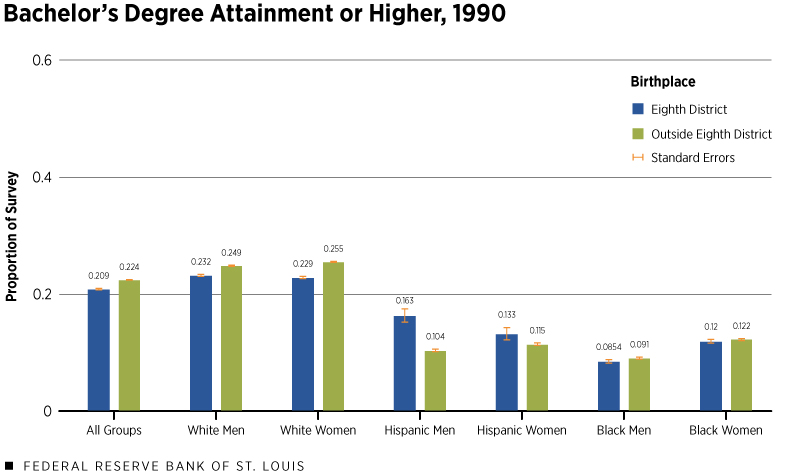How College Attainment Differs by Birthplace
KEY TAKEAWAYS
- Measuring educational attainment by birthplace shows how one’s socioeconomic climate growing up may impact the decision to seek a higher degree.
- Overall, data from 1990 and 2018 show people born in the Federal Reserve’s Eighth District had lower educational attainment levels than those outside it.
- The opposite was true among Hispanic men and Hispanic women, who had higher levels of attainment within the District than outside it.

In late 2016, Janet Yellen, then-chair of the Federal Reserve and incoming secretary of the U.S. Treasury, told University of Baltimore graduates, “Economists are not certain about many things, but we are quite certain that a college diploma or an advanced degree is a key to economic success.”
At the beginning of the 20th century, white men were the only people regularly admitted to degree-granting institutions. Over the next 100 years, higher education became open to people of all backgrounds, and degree attainment rose for everyone.
Nevertheless, gaps in educational attainment across demographic and geographic groups remain. In particular, the stark geographic divide in educational attainment has persisted, even as overall degree attainment has increased.
To measure this gap, in this article we focus on the level of degree attainment based on where a person is born. Measuring college attainment by birthplace—rather than where people happen to live now—shows how the socioeconomic environment in which one grows up impacts the decision to seek a college degree.The data for this article are from the 2014-18 American Community Survey (ACS) and the 1990 census, via the IPUMS database. Each data point in the census and ACS corresponds to a respondent living in the U.S., including his or her birthplace, race, sex and highest level of education attained.
Inside and Outside the Eighth District
Overall, in 1990 and 2018, those born in the Federal Reserve’s Eighth District had a lower level of degree attainment than those born outside the District.Our measure of the Eighth District includes Arkansas, Illinois, Indiana, Kentucky, Mississippi, Missouri and Tennessee, even though only parts of some of those states are included in the Eighth District. Over time, the proportion of those with a degree increased by roughly the same amount inside and outside the Eighth District.To construct a measure of educational attainment, we first dropped all data points without a value for education and limited the sample to people between ages 25 and 30. In the 1990 census, for example, we measured degree attainment for a cohort born between 1960 and 1965.
In 1990, white men and white women were the highest proportions of people with a degree inside and outside the Eighth District. In 1990 and 2018, both groups saw an increase in the number of bachelor’s degree holders, but white women’s attainment increased more sharply.Our demographic groups of interest were white, Black and Hispanic, further subdivided into men and women. The census and ACS do not obtain a large enough sample of Asians and other demographic groups to create consistent measures of college degree attainment by cohort and state of birth, so we excluded them from our graphs. Our measure of degree attainment includes anyone possessing a bachelor’s, master’s, professional or doctoral degree. (See the figure below.)

SOURCES: American Community Survey, U.S. Census Bureau and authors’ calculations.
In 2018, white women in the Eighth District had higher levels of educational attainment than any other demographic group except white women outside the District. White women born in the Eighth District were 4 percentage points less likely to obtain a college degree than those born outside the District, according to the data.

SOURCES: American Community Survey, U.S. Census Bureau and authors’ calculations.
In 1990 and 2018, college attainment for Black 25- to 30-year-old men and women was below average within the District and outside it. In 2018, Black men and Black women had the lowest level of degree attainment across all groups, despite the overall increase in the number of bachelor’s degrees.
As with other demographic groups, women who are Black increased their rate of degree attainment more than men who are Black.
The gap in college attainment between Black people and white people is smaller in the Eighth District than outside it. However, this is largely attributable to lower levels of college attainment for whites in the District, rather than higher college attainment for Blacks.
In 1990 and 2018, Hispanic men and Hispanic women within the District achieved higher levels of college attainment than those outside it. In 1990, Hispanic women in the Eighth District had a lower level of degree attainment than Hispanic men—a relationship that reversed over time. In 1990 a racial gap existed in education between white men and white women and their counterparts in the Hispanic community, but the gap was smaller inside the Eighth District. Twenty-eight years later, every group has seen increases in the proportion of the population with a college degree, but the racial gap remains and it is smaller in the Eighth District. The gap between whites and Hispanics is due to higher educational attainment of Hispanic people and lower educational attainment of white people in the Eighth District.
Degree Attainment in the District
College degree attainment within the Eighth District displays different patterns than in the rest of the country. More people attain bachelor’s degrees outside the Eighth District, but the racial gap in education between white people and Hispanic people and white people and Black people is smaller in the Eighth District than outside it.
Across all groups, women are more likely to obtain a bachelor’s, master’s, professional or doctoral degree than men within the same racial group. Between 1990 and 2018, white women and Hispanic women saw the largest increases in the proportion of people earning bachelor’s degrees, while Hispanic men and Black men saw the smallest increases.
Although these degree-attainment patterns seem to put the Eighth District at a disadvantage compared with the rest of the country, educational attainment levels are clearly higher among Hispanic men and Hispanic women born in the District, offering the potential for higher wages and other advantages a college degree offers.
Possible Reasons for Educational Levels
There are many reasons children born in different states might attain different levels of degrees. First, it is possible that the populations are different: Households inside and outside the Eighth District may differ in parental income, parental education and cultural influences, as well as by demographic groups that differ more finely than the broad categories used in this analysis.
These differences among parents may transmit to their children and be reflected in the college attainment rate. If so, the differences in college attainment could reflect underlying population differences, rather than the socioeconomic environment of a person’s birthplace.
Second, it is possible that geographic differences in degree attainment are driven by differences in access to and quality of education, at the primary and secondary levels or the postsecondary level. While distinguishing between these explanations is beyond the scope of this article, these patterns have important implications for the economic future of children born in the Eighth District and businesses seeking a highly educated workforce.
Endnotes
- The data for this article are from the 2014-18 American Community Survey (ACS) and the 1990 census, via the IPUMS database. Each data point in the census and ACS corresponds to a respondent living in the U.S., including his or her birthplace, race, sex and highest level of education attained.
- Our measure of the Eighth District includes Arkansas, Illinois, Indiana, Kentucky, Mississippi, Missouri and Tennessee, even though only parts of some of those states are included in the Eighth District.
- To construct a measure of educational attainment, we first dropped all data points without a value for education and limited the sample to people between ages 25 and 30. In the 1990 census, for example, we measured degree attainment for a cohort born between 1960 and 1965.
- Our demographic groups of interest were white, Black and Hispanic, further subdivided into men and women. The census and ACS do not obtain a large enough sample of Asians and other demographic groups to create consistent measures of college degree attainment by cohort and state of birth, so we excluded them from our graphs. Our measure of degree attainment includes anyone possessing a bachelor’s, master’s, professional or doctoral degree.
Views expressed in Regional Economist are not necessarily those of the St. Louis Fed or Federal Reserve System.
For the latest insights from our economists and other St. Louis Fed experts, visit On the Economy and subscribe.
Email Us



